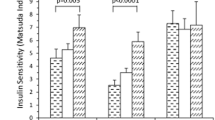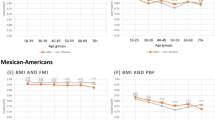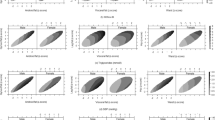Abstract
AIMS:
To study the association between lower-body fat and estimates of whole-body insulin sensitivity in middle-aged men with and without a history of juvenile onset obesity, and to determine the possible mediating role of fasting serum adiponectin level as an insulin-sensitizing peptide.
METHODS:
A total of 401 men aged 39–65 y, body mass index 18–54 kg/m2, participated in the study. The following variables were measured on the study participants: regional body fat distribution as assessed by dual energy X-ray absorptiometry, abdominal sagittal diameter, maximal oxygen uptake (VO2max), physical activity, fasting and post-glucose load levels of plasma glucose, serum insulin, and blood non-esterified fatty acid plus fasting levels of serum adiponectin and HbA1c.
RESULTS:
Lower-body fat mass was positively associated with insulin sensitivity as estimated by Matsudas index also after adjusting for age, lean tissue mass, trunkal fat mass, weight changes since draft board examination, VO2max and the level of physical activity. In a subgroup of men selected for a large lower-body fat mass, fasting serum insulin concentration was 24% lower (P<0.01) and fasting serum adiponectin 33% higher (P<0.005) compared to a subgroup of men with a small lower-body fat mass but with similar trunkal fat mass.
CONCLUSION:
Lower-body fat mass is positively associated with an estimate of insulin sensitivity independently of trunkal fat mass in both lean and obese middle-aged men and this effect could partly be statistically explained by variations in serum adiponectin levels.
This is a preview of subscription content, access via your institution
Access options
Subscribe to this journal
Receive 12 print issues and online access
$259.00 per year
only $21.58 per issue
Buy this article
- Purchase on Springer Link
- Instant access to full article PDF
Prices may be subject to local taxes which are calculated during checkout


Similar content being viewed by others
References
Bonora E . Relationship between regional fat distribution and insulin resistance. Int J Obes Relat Metab Disord 2000; 24 (Suppl 2): S32–S35.
Abate N, Garg A, Peshock RM, Stray-Gundersen J, Grundy SM . Relationships of generalized and regional adiposity to insulin sensitivity in men. J Clin Invest 1995; 96: 88–98.
Goodpaster BH, Thaete FL, Simoneau JA, Kelley DE . Subcutaneous abdominal fat and thigh muscle composition predict insulin sensitivity independently of visceral fat. Diabetes 1997; 46: 1579–1585.
Smith SR, Lovejoy JC, Greenway F, Ryan D, deJonge L, de la Bretonne J, Volafova J, Bray GA . Contributions of total body fat, abdominal subcutaneous adipose tissue compartments, and visceral adipose tissue to the metabolic complications of obesity. Metabolism 2001; 50: 425–435.
Van Pelt RE, Evans EM, Schechtman KB, Ehsani AA, Kohrt WM . Contribution of total and regional fat mass to risk for cardiovascular disease in older women. Am J Physiol Endocrinol Metab 2002; 282: E1023–E1028.
Seidell JC, Pérusse L, Després JP, Bouchard C . Waist and hip circumferences have independent and opposite effects on cardiovascular disease risk factors: the Québec Family Study. Am J Clin Nutr 2001; 74: 315–321.
Snijder MB, Dekker JM, Visser M, Yudkin JS, Stehouwer CD, Bouter LM, Heine RJ, Nijpels G, Seidell JC . Larger thigh and hip circumferences are associated with better glucose tolerance: The Horn Study. Obes Res 2003; 11: 104–111.
Pajvani UB, Scherer PE . Adiponectin: systemic contributor to insulin sensitivity. Curr Diab Rep 2003; 3: 207–213.
Nindl BC, Friedl KE, Marchitelli LJ, Shippee RL, Thomas CD, Patton JF . Regional fat placement in physically fit males and changes with weight loss. Med Sci Sports Exerc 1996; 28: 786–793.
Rosenthal M, Haskell WL, Solomon R, Widstrom A, Reaven G . Demonstration of a relationship between level of physical training and insulin-stimulated glucose utilization in normal humans. Diabetes 1983; 32: 408–411.
Sonne-Holm S, Sorensen TI, Jensen G, Schnohr P . Independent effects of weight change and attained body weight on prevalence of arterial hypertension in obese and non-obese men. Br Med J 1989; 299: 767–770.
Report of a WHO Consultation 1999. Definition, diagnosis and classification of diabetes mellitus and its complications. WHO, Department of Non-communicable Disease Surveillance, Geneva, 1999.
Matsuda M, DeFronzo RA . Insulin sensitivity indices obtained from oral glucose tolerance testing. Comparison with the euglycemic insulin clamp. Diabetes Care 1999; 22: 1462–1470.
Report of a WHO Expert Committee 1995. Physical status: The use and interpretation of anthropometry. Technical Report Series No. 854, WHO, Geneva, 1995.
Treuth MS, Hunter GR, Kekes-Szabo T . Estimating intraabdominal adipose tissue in women by dual-energy X-ray absorptiometry. Am J Clin Nutr 1995; 62: 527–532.
Sjöström CD, Håkangård C, Lissner L, Sjöström L . Body compartment and subcutaneous adipose tissue distribution—risk factor patterns in obese subjects. Obes Res 1995; 3: 9–22.
Raynaud E, Pérez-Martin A, Brun JF, Fédou C, Mercier J . Insulin sensitivity measured with the minimal model is higher in moderately overweight women with predominantly lower body fat. Horm Metab Res 1999; 31: 415–417.
Bolinder J, Engfeldt P, Ostman J, Arner P . Site differences in insulin receptor binding and insulin action in subcutaneous fat of obese females. J Clin Endocrinol Metab 1983; 57: 455–461.
Arner P . Role of antilipolytic mechanisms in adipose tissue distribution and function in man. Acta Med Scand Suppl 1988; 723: 147–152.
Rebuffe-Scrive M, Enk L, Crona N, Lonnroth P, Abrahamsson L, Smith U, Bjorntorp P . Fat cell metabolism in different regions in women. Effect of menstrual cycle, pregnancy, and lactation. J Clin Invest 1985; 75: 1973–1976.
Smith U . Regional differences in adipocyte metabolism and possible consequences in vivo. Int J Obes Relat Metab Disord 1985; 9 (Suppl 1): 145–148.
Tschritter O, Fritsche A, Thamer C, Haap M, Shirkavand F, Rahe S, Staiger H, Maerker E, Haring H, Stumvoll M . Plasma adiponectin concentrations predict insulin sensitivity of both glucose and lipid metabolism. Diabetes 2003; 52: 239–243.
Martin ML, Jensen MD . Effects of body fat distribution on regional lipolysis in obesity. J Clin Invest 1991; 88: 609–613.
Dowling HJ, Fried SK, Pi-Sunyer X . Insulin resistance in adipocytes of obese women: effects of body fat distribution and race. Metabolism 1995; 44: 987–995.
Stolic M, Russell A, Hutley L, Fielding G, Hay J, MacDonald G, Whitehead J, Prins J . Glucose uptake and insulin action in human adipose tissue—influence of BMI, anatomical depot and body fat distribution. Int J Obes Relat Metab Disord 2002; 26: 17–23.
Ljung T, Andersson B, Bengtsson BA, Bjorntorp P, Marin P . Inhibition of cortisol secretion by dexamethasone in relation to body fat distribution: a dose–response study. Obes Res 1996; 4: 277–282.
Fallo F, Scarda A, Sonino N, Paoletta A, Boscaro M, Pagano C, Federspil G, Vettor R . Effect of glucocorticoids on adiponectin: a study in healthy subjects and Cushing's syndrome. Eur J Endocrinol 2004; 150: 339–344.
Norman RL . Effects of corticotropin-releasing hormone on luteinizing hormone, testosterone, and cortisol secretion in intact male rhesus macaques. Biol Reprod 1993; 49: 148–153.
Bhasin S . Effects of testosterone administration on fat distribution, insulin sensitivity, and atherosclerosis progression. Clin Infect Dis 2003; 37 (Suppl 2): S142–S149.
Mårin P . Testosterone and regional fat distribution. Obes Res 1995; 3 (Suppl 4): 609S–612S.
Jankowska EA, Rogucka E, Medras M, Welon Z . Relationships between age-related changes of sex steroids, obesity and body fat distribution among healthy Polish males. Med Sci Monitor 2000; 6: 1159–1164.
Haffner SM, Karhapaa P, Mykkanen L, Laakso M . Insulin resistance, body fat distribution, and sex hormones in men. Diabetes 1994; 43: 212–219.
Simon D, Charles MA, Lahlou N, Nahoul K, Oppert JM, Gouault-Heilmann M, Lemort N, Thibult N, Joubert E, Balkau B, Eschwege E . Androgen therapy improves insulin sensitivity and decreases leptin level in healthy adult men with low plasma total testosterone: a 3-month randomized placebo-controlled trial. Diabetes Care 2001; 24: 2149–2151.
Nishizawa H, Shimomura I, Kishida K, Maeda N, Kuriyama H, Nagaretani H, Matsuda M, Kondo H, Furuyama N, Kihara S, Nakamura T, Tochino Y, Funahashi T, Matsuzawa Y . Androgens decrease plasma adiponectin, an insulin-sensitizing adipocyte-derived protein. Diabetes 2002; 51: 2734–2741.
Forouhi NG, Jenkinson G, Thomas EL, Mullick S, Mierisova S, Bhonsle U, McKeigue PM, Bell JD . Relation of triglyceride stores in skeletal muscle cells to central obesity and insulin sensitivity in European and South Asian men. Diabetologia 1999; 42: 932–935.
Weiss R, Dufour S, Groszmann A, Petersen K, Dziura J, Taksali SE, Shulman G, Caprio S . Low adiponectin levels in adolescent obesity: a marker of increased intramyocellular lipid accumulation. J Clin Endocrinol Metab 2003; 88: 2014–2018.
Maeda N, Takahashi M, Funahashi T, Kihara S, Nishizawa H, Kishida K, Nagaretani H, Matsuda M, Komuro R, Ouchi N, Kuriyama H, Hotta K, Nakamura T, Shimomura I, Matsuzawa Y . PPARγ ligands increase expression and plasma concentrations of adiponectin, an adipose-derived protein. Diabetes 2001; 50: 2094–2099.
Combs TP, Wagner JA, Berger J, Doebber T, Wang WJ, Zhang BB, Tanen M, Berg AH, O'Rahilly S, Savage DB, Chatterjee K, Weiss S, Larson PJ, Gottesdiener KM, Gertz BJ, Charron MJ, Scherer PE, Moller DE . Induction of adipocyte complement-related protein of 30 kilodaltons by PPARgamma agonists: a potential mechanism of insulin sensitization. Endocrinology 2002; 143: 998–1007.
Yu JG, Javorschi S, Hevener AL, Kruszynska YT, Norman RA, Sinha M, Olefsky JM . The effect of thiazolidinediones on plasma adiponectin levels in normal, obese, and type 2 diabetic subjects. Diabetes 2002; 51: 2968–2974.
Staiger H, Tschritter O, Machnann J, Thamer C, Fritsche A, Maerker E, Schick F, Haring HU, Stumvoll M . Relationship of serum adiponectin and leptin concentrations with body fat distribution in humans. Obes Res 2003; 11: 368–372.
Acknowledgements
We would like to thank Christina Cuthbertson for her linguistic work on the manuscript. This study was supported by grants from The Danish Medical Research Council, The Danish National Reseach Foundation and The Velux Foundation.
Author information
Authors and Affiliations
Corresponding author
Rights and permissions
About this article
Cite this article
Buemann, B., Sørensen, T., Pedersen, O. et al. Lower-body fat mass as an independent marker of insulin sensitivity—the role of adiponectin. Int J Obes 29, 624–631 (2005). https://doi.org/10.1038/sj.ijo.0802929
Received:
Revised:
Accepted:
Published:
Issue Date:
DOI: https://doi.org/10.1038/sj.ijo.0802929
Keywords
This article is cited by
-
Obesity-related insulin resistance: implications for the surgical patient
International Journal of Obesity (2015)
-
Circulating adiponectin levels are associated with peak oxygen uptake in Japanese
Environmental Health and Preventive Medicine (2014)
-
Intraperitoneal Fat and Insulin Resistance in Obese Adolescents
Obesity (2010)
-
Common variants near MC4R in relation to body fat, body fat distribution, metabolic traits and energy expenditure
International Journal of Obesity (2010)
-
Gluteofemoral body fat as a determinant of metabolic health
International Journal of Obesity (2010)



